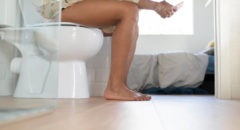
Generally, back pain can be caused by a variety of factors, including poor posture, muscle imbalances, and lack of core strength. A seated workout that focuses on building core strength can be an effective way to alleviate back pain.
It’s important to note that everyone’s body is different, and what works for one person may not work for another.
It’s always best to consult with a healthcare professional or physical therapist before beginning any new workout routine, especially for back pain. They can help you determine the cause of your back pain and can recommend exercises that are safe and effective for you.
Here is a 10-minute seated spinal workout to help with your back pain:
1. Seated spinal twists
Sit tall in your chair with your feet flat on the floor. Place your left hand on the back of the chair and twist your torso to the right, using your right hand to hold onto the chair for balance. Hold for five seconds and repeat on the other side. Repeat the twist ten times on each side.
2. Shoulder blade squeezes
Sit with your back straight and your feet flat on the floor. Squeeze your shoulder blades together and hold for 5 seconds. Release and repeat ten times.
RELATED: Back Pain Prevention: 5 Harmful Habits
3. Seated hamstring stretches
Sit on the edge of your chair with your feet flat on the floor. Slowly lean forward, keeping your back straight, and reach for your toes. Hold for 15 seconds and release. Repeat three times.

4. Seated spinal extensions
Sit with your back straight and your feet flat on the floor. Slowly arch your back and reach your arms forward. Hold for five seconds and release. Repeat ten times.
5. Seated leg raises
Sit with your back straight and your feet flat on the floor. Raise one leg off the ground, keeping your knee straight. Hold for five seconds and release. Repeat ten times on each leg.
6. Seated neck stretches
Sit with your back straight and your feet flat on the floor. Tilt your head to one side, holding onto your ear with your hand. Hold for 15 seconds and release. Repeat on the other side.
7. Seated back stretches
Sit with your back straight and your feet flat on the floor. Reach your arms behind you and hold onto the back of your chair. Arch your back and hold for 15 seconds. Release and repeat three times.
RELATED: 7 Ways To Naturally Relieve Back Pain
8. Cat-cow stretch
Sit on the edge of your chair with your hands on your knees. Arch your back and tilt your head towards the ceiling; hold for five seconds. Lower your head and round your back, and hold for five seconds. Repeat this movement ten times.

9. Seated twist with a twist
Sit on the edge of your chair with your feet flat on the floor. Place your left hand on the back of the chair, twist your torso to the right, and using your right hand, reach behind your back and hold onto the left armrest of the chair. Hold for five seconds and repeat on the other side. Repeat the twist ten times on each side
10. Seated spinal curls
Sit on the edge of your chair with your feet flat on the floor. Slowly lower your head and round your shoulders forward, hold for five seconds, release and repeat ten times.
It is important to check with your doctor or physical therapist before starting any new exercise program, especially if you have any pre-existing conditions.
The correct spinal position is key to spinal health. Concentrate on your walking posture and sitting position. Stretch often. This will help your spinal health.

When to see a doctor
It’s important to see a doctor for back pain if you experience any of the following:
Severe or Persistent Pain:
- Pain that lasts longer than a few weeks and doesn’t improve with home treatment.
- Severe pain that doesn’t improve with rest.
- Chronic back pain that lasts for three months or longer.
- Pain that is constant or intense, especially at night or when lying down.
- Pain that keeps getting worse over time.
Pain that Radiates:
Pain that spreads down one or both legs, especially if it goes below the knee (this could be sciatica).
Accompanying Symptoms:
- Weakness, numbness, or tingling in one or both legs.
- New bowel or bladder problems (incontinence or difficulty). This is a serious red flag and requires immediate medical attention.
- Unexplained weight loss.
- Fever.
- Pain after an injury such as a fall, blow to the back, or car accident (even a minor one).
- Pain that wakes you up at night.
- Pain accompanied by severe belly pain.
Other Considerations:
- If you have a history of cancer.
- If you have a weakened immune system.
- If you have been using steroids for a long time.
- If you have a history of intravenous drug use.
Don’t hesitate to seek medical attention sooner if your pain is severe or if you are worried. Your doctor can properly diagnose the cause of your back pain and recommend the most appropriate treatment plan.









